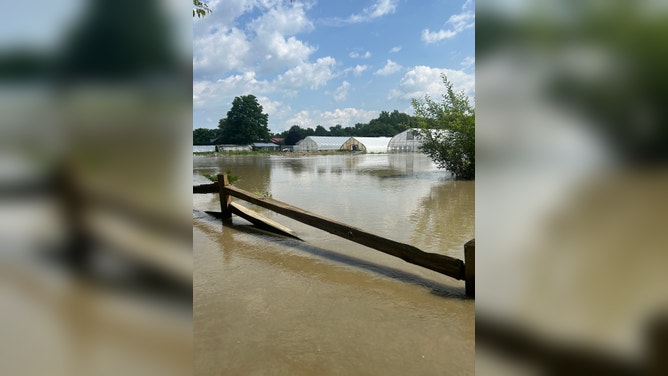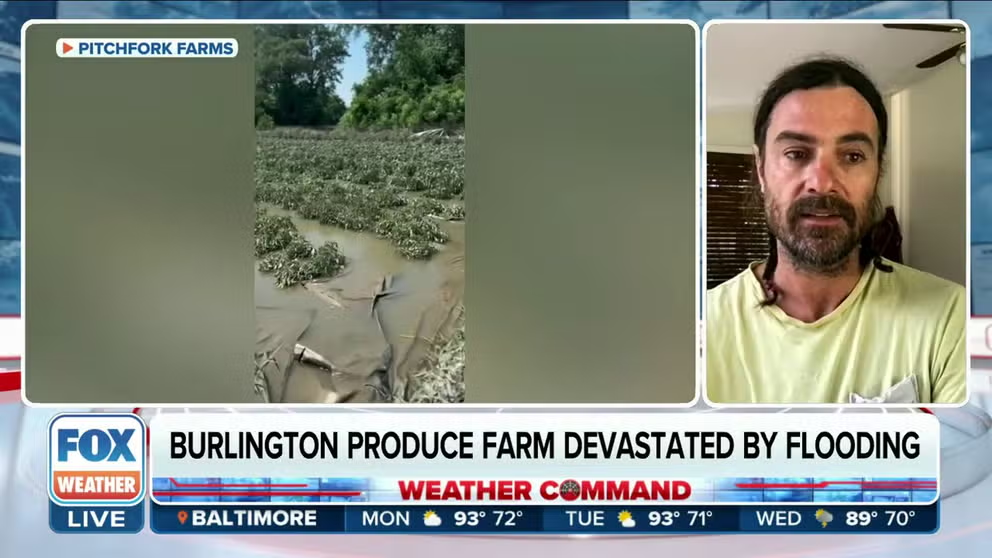Vermont flooding destroys produce farm's entire crop
Seven feet of floodwater from the Winooski River covered crops, including baby kale, arugula and lettuce. Around this time of year, the farm staff would be preparing for fall crops, including carrots, beets and cabbage that grow through the winter.
Vermont flooding disaster swamps local farms
Historic flooding in Vermont caused devastating damages to crops. Seven feet of flood waters swamped Pitchfork Farm. Owner Eric Seitz told FOX Weather he hopes to start planting again after the flooding cleanup.
BURLINGTON, Vt. – Flooding caused by torrential rains in Vermont devastated farm crops, leaving local farmers scrambling to clean up in hopes of replanting before it's too late in the season.
Pitchfork Farm co-owner Eric Seitz said he knew it wouldn't be good when he saw the initial forecast calling for 3 inches the Friday before the rainfall started.
"Three inches kind of across the state, all that water ends up in the river that runs along our farm," Seitz said. "And as it turned out, it ended up being around 7 or 8 inches."
The Burlington farm is known for its carrots and other produce supplied to local restaurants and grocery stores. Seitz said he checks the forecast for rain daily because heavy rainfall can be problematic for carrot seed germination.
‘Nothing to do but stand and watch the water’
When the Winooski River began to flood the Intervale, there wasn't anything they could do to save the crops.
VERMONT HIGH SCHOOL FOOTBALL PLAYER HELPS WITH RECOVERY IN HIS BARE FEET AFTER LOSING HOME
"We were scrambling to harvest what we could, and then Tuesday morning, there's nothing to do but stand there and watch the water," Seitz said.
Seven feet of floodwater covered crops, including baby kale, arugula and lettuce.
After the rain stopped, the farm staff used kayaks and canoes to paddle through the vegetable fields covered in feet of water.
In 18 seasons, this is the second devastating flood for the farm. First, flooding was caused by Hurricane Irene in 2019, and now the most recent July flooding event.
The flash floods came during the middle of harvest season for fruiting crops, including peppers and watermelon. Around this time of year, the farm staff would prepare to plant fall crops, including carrots, beets and fall cabbage that grow through the winter.
"We grow about 100,000 pounds of carrots, for instance. We just finished selling the last of last year's crops, and the window on getting those seeded is rapidly closing," Seitz said. "It's not looking great for the business."
Supporters of the farm started a GoFundMe fundraiser for $100,000 to help Seitz and co-owner Rob Rock continue to pay their employees and keep their business afloat until next season. In five days, the fundraiser has garnered more than $66,000. This would be a lot for an individual, but it likely won't be enough for a small business supporting 12 employees to keep their staff off unemployment.
"That amount, while unbelievable, and just extraordinarily generous, that's about two and a half to three weeks' worth of revenue for us in July and August," Seitz said.
The latest forecast for more rain will hinder further efforts to replant.
"We just need the fields to dry up, and we need the rain to stop," Seitz said.
Rains leave ‘staggering’ flood damages to Vermont agriculture industry

Flooding at Pitchfork Farm vegetable fields in Vermont after historic flooding. (Image: Pitchfork Farm)
(FOX Weather)
According to the Vermont Agency of Agriculture, Food & Markets (VAAFM) several growers contacted the department about handling produce and fields after the flooding.
"Under U.S. law, crops, where the edible portion of the plant has contacted floodwaters, are considered adulterated and cannot be sold for human consumption," according to the Department of Agriculture. "Because floodwaters may contain sewage, chemicals, heavy metals, pathogens or other contaminants, these crops must be discarded, destroyed or tilled into the soil."
The department has additional resources available online for agriculture businesses to help after the floods.
VAAFM Director of Communications and Policy Scott Waterman said many agricultural lands are located near the rivers in Vermont. The VAAFM is still in the process of assessing the damages to farmlands.
Waterman said even with the ongoing assessment it's safe to say the losses are "excessive, potentially staggering" for Vermont farmers.
For farmers unsure where to start, they can by documenting damages and file a report with their county Farm Service Agency office.
The process of receiving help after the floods will be a two-part process for farmers.
Any help for damages to crops and land will be through the U.S. Department of Agriculture Disaster Declaration and damages to infrastructure, including barns, will be through FEMA.





